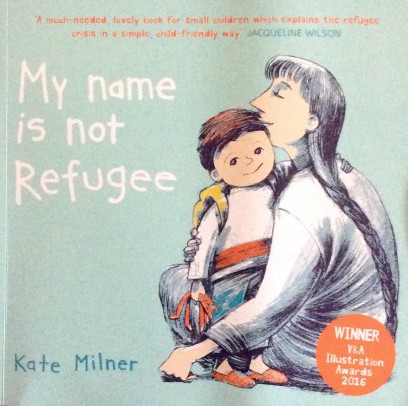Inspiring Young Readers
 posted on 26 May 2017
posted on 26 May 2017
My Name Is Not Refugee by Kate Milner
This is a welcome addition to the (far too few) picture books that include informative and sensitive stories about the refugee experience. This one is the well deserved winner of the V and A Illustration Award 2016 and has a boldly drawn cover that immediately challenges the stereotype of books about refugees by presenting you with the warm relationship between a young boy and his mother. This is not the usual image depicting need , sorrow and poverty but one where the child, carrying a small rucksack on his back to signify a journey, looks out at us smiling and the mother holds him close, seen in profile but also smiling with her eyes closed, perhaps imagining a happy future or just treasuring the moment.
The author succeeds in conveying a wealth of information without the need for explanatory text. So, for instance, the end covers show starkly repeated rows of white tents in a refugee camp which is clearly part of the refugee experience but instead of over-emphasising the threat this might carry, the main content of the story focusses on the reassurance that the mother provides when she realises that she and her child have to leave their home. This of course means saying goodbye to people and places but the emphasis is practical from the start, deciding what to take and involving the reader in the decision making by asking direct questions in the corner of several pages. However, Milner does not hold back from showing 'a place where there is no water in the taps and no one to pick up the rubbish'. This shows how well she knows her intended young readers who will be very keen to know why people leave their homes. She also shows the rather solid little boy, drawn in a style that is perhaps influenced by Maurice Sendak, striding out confidently and moving back and forth from left to right and top to bottom of a page. By the top of the next page he is getting tired and fed up with the novelty of the journey and we can feel his physical exhaustion as she asks us ' How far could you walk'?
The mood changes from this point as the mother and child have long periods of waiting as they travel and joining queues of other tired refugees.
Despite all this, Milner manages to keep the tone of the book upbeat because, as happens for all parents of young children on long journeys, distracting games help to pass the time. As he sleeps on a floor surrounded by people of all shapes and sizes, the question posed is ' where would you brush your teeth or change your pants'? When the illustration shows the mother standing on the edge of an unfriendly looking crowd looking confused as she tries to make herself understood, the reader is invited to reflect on their own knowledge of different languages. I especially liked the double page spread where the boy is faced with unfamiliar food that he clearly doesn't like the look of. Wariness about unfamiliar food is something that any child can identify with and they are once again invited to share their own experiences: ' What is the weirdest food you have ever eaten?'
The story has a positive ending that shows them having arrived somewhere where they feel safe and can begin to make a new home. Now the reader is asked to think about what it might feel like to learn a new language and to feel like a stranger in a new place.
I really enjoyed this well designed picture book written and illustrated by a first time author and published by Barrington Stoke. The beautiful illustrations alongside the simple text touch on many common childhood fears, provide gentle reassurance and also indicate practical solutions along the way. It is very thought provoking and will hopefully be widely used by parents and teachers to help children to develop empathy for those who may be living through similar experiences.
Finally, there's a great quote from UNICEF UK on the back cover which underlines how a book like this 'helps show readers that children forced from their homes are not just refugees but children just like them'.
Karen Argent
May 2017